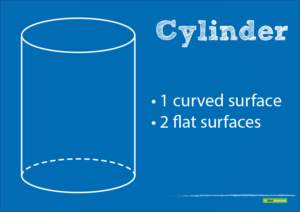For over a year now, the Teach Starter team have been debating how to label the properties of a cone and cylinder. Who would have thought 3D objects would be so controversial?
Most of us were taught that cones and cylinders have edges and faces!
However, this has changed and there is a mathematical reason behind this change!
The NSW Syllabus outlines it very clearly:
- In geometry, the term ‘face’ refers to a flat surface with only straight edges, as in prisms and pyramids, eg. a cube has six faces.
- Curved surfaces, such as those found in cylinders, cones, and spheres, are not classified as ‘faces’.
- Similarly, flat surfaces with curved boundaries, such as the circular surfaces of cylinders and cones, are not ‘faces’.
- In geometry, the term ‘edge’ refers to the interval (straight line) formed where two faces of a three-dimensional object meet.
- The NSW Syllabus describes a cylinder as a 3D object that has two flat surfaces, one curved surface, no faces, no edges and no vertices.
What are your thoughts? Does your school do something different?









Comments